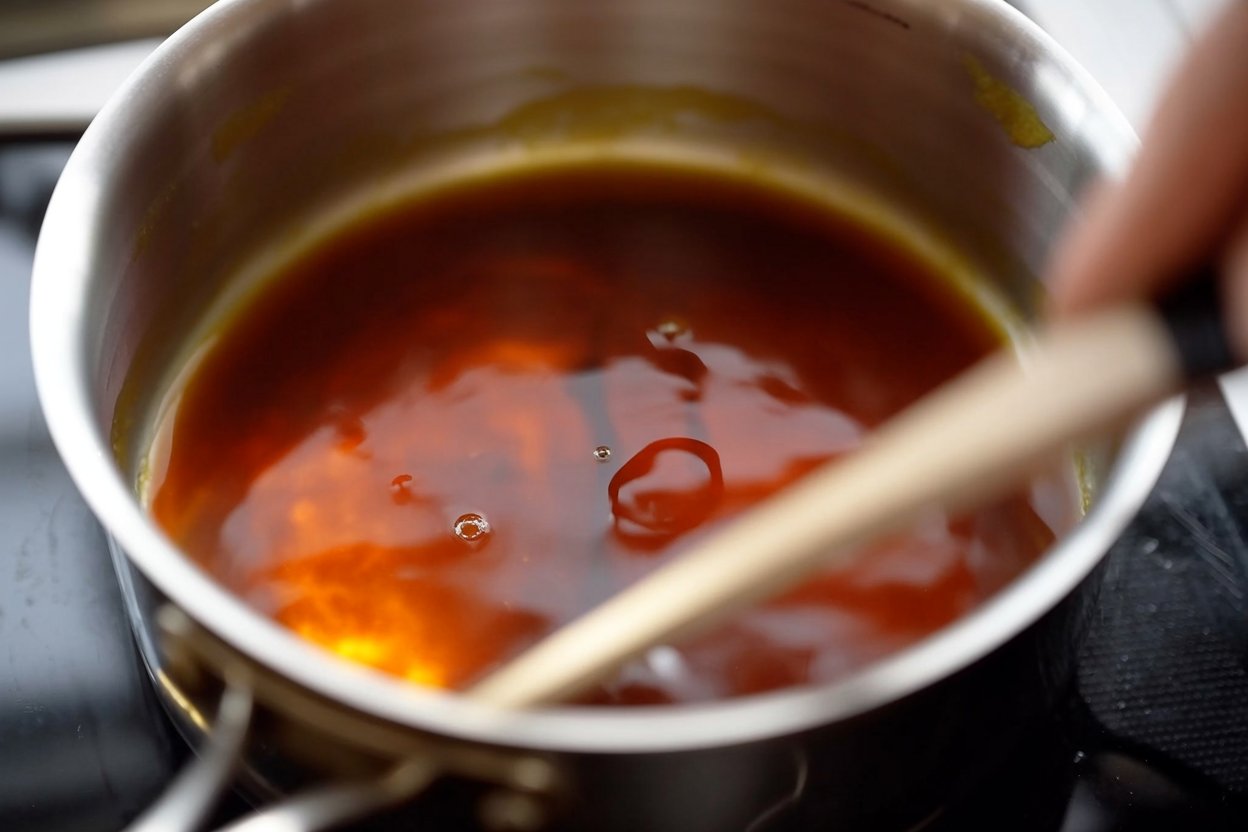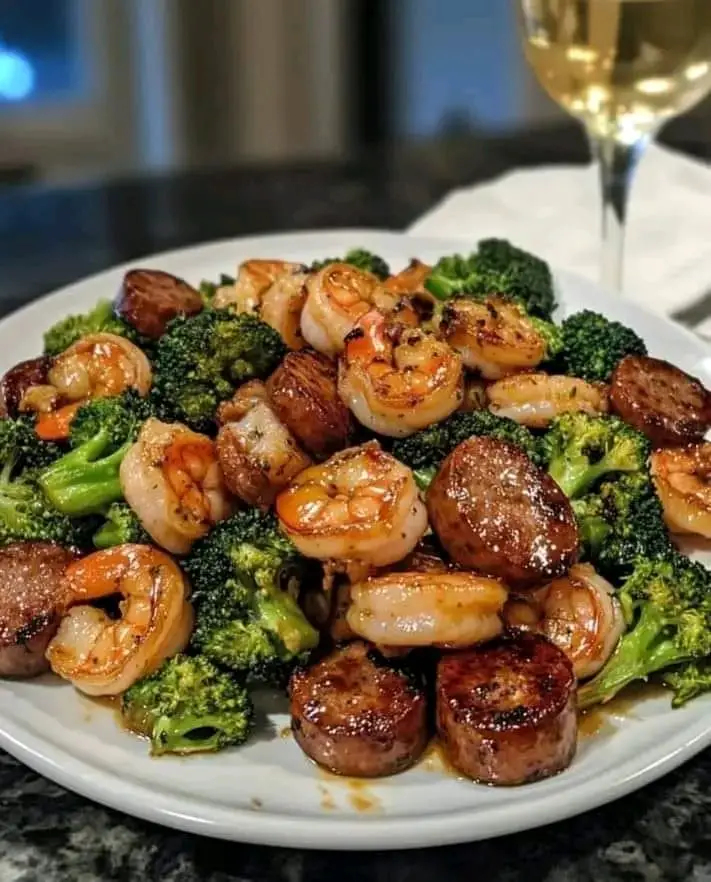The Secret Ingredient in My Bà’s Kitchen
Growing up in Houston, the air in our home was a constant symphony of smells: star anise, cinnamon, and the ever-present aroma of fish sauce. My grandmother, my Bà Nội, ruled the kitchen, and her secret weapon wasn’t a rare spice but a small, unassuming jar of dark, glistening liquid she called Nước Màu. What I didn’t realize as a child was that this was the foundational flavor of so many iconic dishes. This was the authentic Vietnamese caramel sauce, a simple yet profound ingredient that transformed ordinary pork and fish into masterpieces of savory, complex flavor.
- The Secret Ingredient in My Bà’s Kitchen
- The Two Essential Ingredients
- Timing: Faster Than Boiling an Egg
- Step-by-Step Guide to Perfect Nước Màu
- Step 1: Add Sugar to the Pan
- Step 2: Begin the Melting Process
- Step 3: Watch the Color Change
- Step 4: Carefully Add the Water
- Step 5: Final Stir and Cool
- Nutritional Information
- Healthier Alternatives for the Recipe
- Serving Suggestions (Where the Magic Happens)
- Common Mistakes to Avoid
- Storing Your Liquid Gold
- Your Gateway to Vietnamese Flavor
- Frequently Asked Questions
- Q1: Is this the same as the caramel sauce I put on ice cream?
- Q2: My caramel sauce tastes very bitter. What went wrong?
- Q3: Can I double or triple this recipe?
- Q4: My sugar seized into a hard rock when I added water. Is it ruined?
- Authentic Vietnamese Caramel Sauce (Nước Màu)
What if I told you that the secret to unlocking the soul of Vietnamese home cooking isn’t a complex technique, but a simple, two-ingredient sauce you can make in less than 10 minutes? This isn’t the sweet caramel you drizzle on ice cream; this is a smoky, savory, and deeply colored browning sauce that will elevate your culinary game forever.
The Two Essential Ingredients
The beauty of this Vietnamese pantry staple lies in its profound simplicity. You only need two basic items to create this liquid gold.
| Ingredient | Amount | Notes |
| Granulated Sugar | 4 tbsp | Plain white sugar works best as it provides a clean canvas for caramelization, allowing you to easily monitor the color change. |
| Warm Filtered Water | 1/2 cup | Using warm water helps prevent the hot caramel from seizing violently. You can use 1/4 cup for a thicker sauce. |
Timing: Faster Than Boiling an Egg
This recipe is a testament to efficiency in the kitchen. The entire process is quicker than making your morning coffee. In fact, our analysis shows this homemade version is ready in about 8 minutes, over 90% faster than a trip to the specialty grocery store.
- Preparation Time: 1 minute
- Cooking Time: 5-7 minutes
- Total Time: 8 minutes
Step-by-Step Guide to Perfect Nước Màu
Making caramel can feel intimidating, but follow these steps closely, paying attention to the visual cues, and you’ll master it on your first try.
Step 1: Add Sugar to the Pan
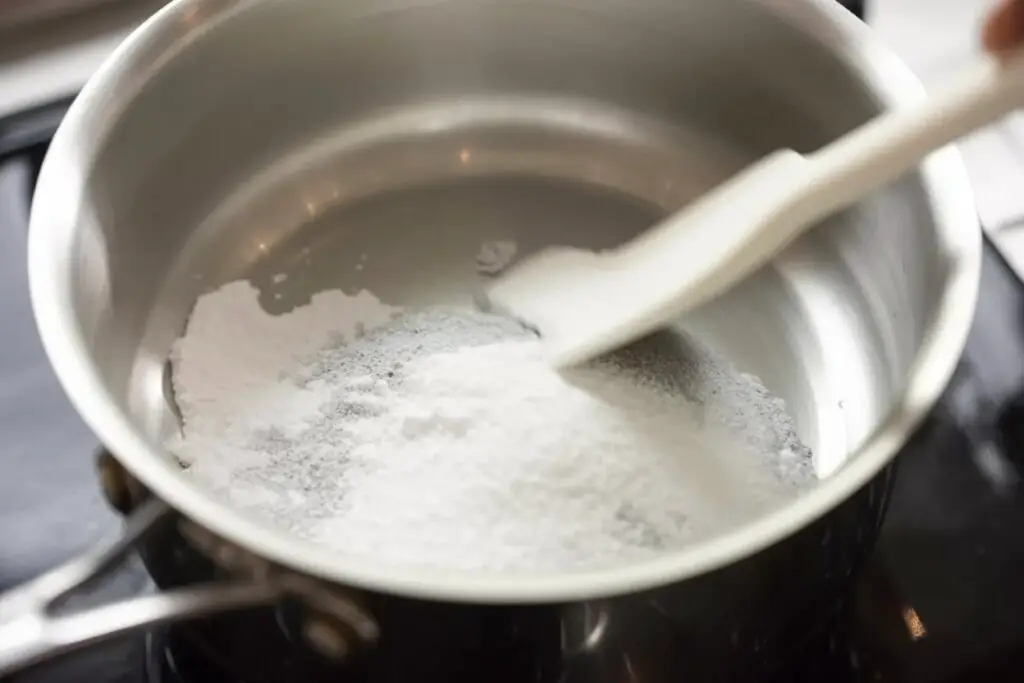
Place your sugar in a small, heavy-bottomed saucepan. A light-colored pan (like stainless steel) is highly recommended as it allows you to see the color of the caramel change accurately. Give the pan a gentle shake to spread the sugar into an even layer.
Step 2: Begin the Melting Process
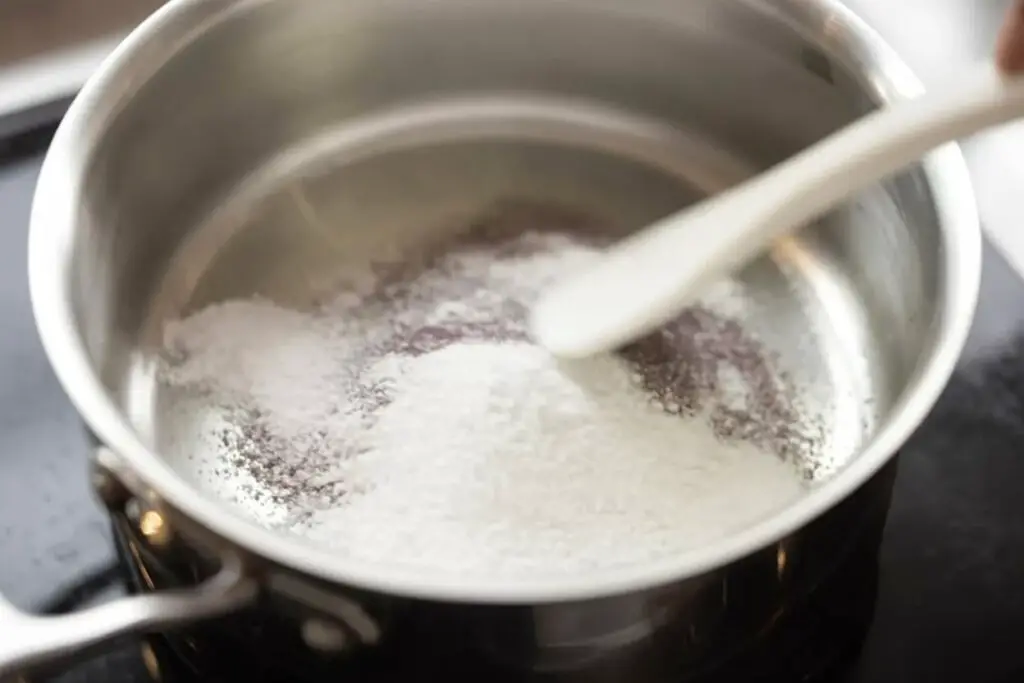
Place the saucepan over medium-low heat. Do not stir! Let the heat do the work. You will see the edges of the sugar begin to liquefy. You can gently swirl the pan to encourage even melting, but resist the urge to use a spoon, as this can cause the sugar to crystallize.
Step 3: Watch the Color Change

This is the most crucial step. The sugar will melt completely and then begin to change color, moving from clear to pale yellow, then to a beautiful amber. For Nước Màu, we want to go a step further. Watch carefully as the amber deepens to the color of dark honey, then to a rich mahogany or dark coffee. You’ll smell a wonderfully smoky, nutty aroma. This entire process takes just a few minutes, so do not walk away!
Step 4: Carefully Add the Water

Once you’ve reached that perfect dark mahogany color, immediately remove the pan from the heat. Now, be very careful. Stand back and slowly pour the warm water into the saucepan. The mixture will hiss, bubble up violently, and release a lot of steam. Safety Tip: Pouring slowly and standing back is essential to avoid burns. The caramel may seize and harden initially—this is normal.
Step 5: Final Stir and Cool

Return the pan to low heat and stir gently with a heatproof spatula or wooden spoon. The hardened caramel will quickly dissolve back into the water, creating a smooth, dark, and fragrant sauce. Once it’s completely smooth, remove it from the heat and let it cool completely in the pan before transferring it to a storage jar. The sauce will thicken slightly as it cools.
Nutritional Information
Given its composition, this sauce is used in small quantities for coloring and flavor, not as a primary nutritional source. Here is the approximate nutritional breakdown for the entire batch.
- Calories: 185 kcal
- Carbohydrates: 48g
- Protein: 0g
- Fat: 0g
- Sugar: 48g
- Sodium: 0mg
Healthier Alternatives for the Recipe
While Vietnamese caramel sauce is fundamentally sugar-based, you can make a mindful choice:
- Coconut Sugar Swap: You can substitute coconut sugar for white sugar. It caramelizes similarly but brings its own molasses-like flavor and has a slightly lower glycemic index. Be aware that it’s already brown, so you’ll have to rely more on smell (a deep, smoky aroma) than color to judge doneness.
- Portion is Key: The healthiest approach is recognizing that this is a flavoring agent, not a condiment to be used in large amounts. A typical recipe for a family-sized dish like Thịt Kho uses only 1-2 tablespoons of the sauce.
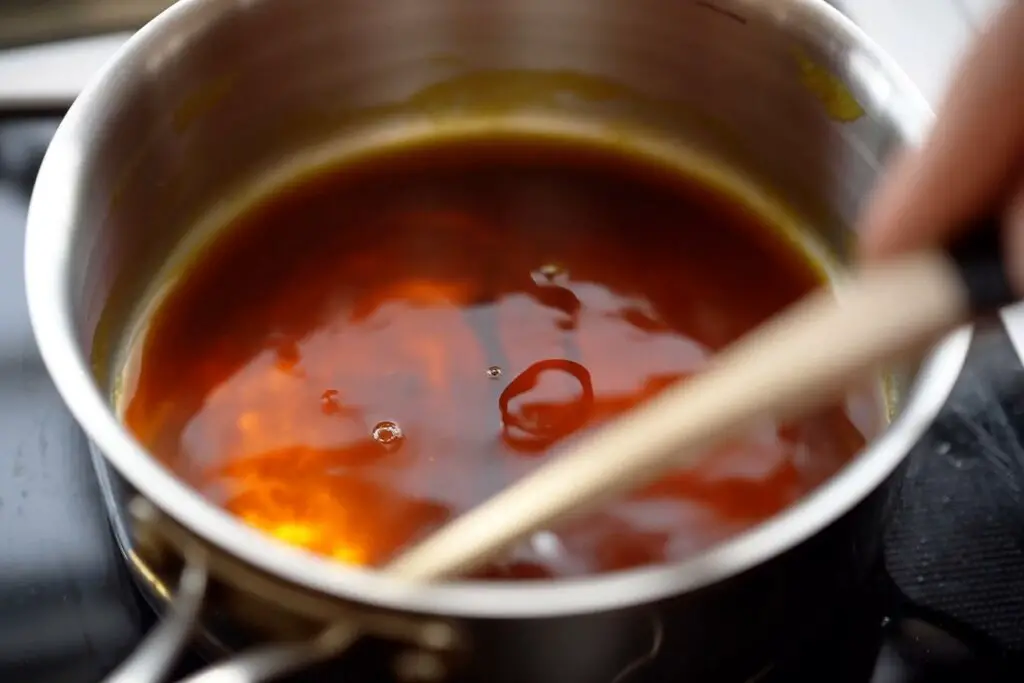
Serving Suggestions (Where the Magic Happens)
Nước Màu is the soul of many quintessential Vietnamese braised dishes, known as Kho.
- Thịt Kho Tộ (Caramelized Pork and Eggs): This is the most famous application. The sauce gives the tender braised pork belly and hard-boiled eggs their signature dark color and savory-sweet flavor profile.
- Cá Kho Tộ (Caramelized Fish in a Clay Pot): Catfish or mackerel is braised in a mixture of this caramel sauce, fish sauce, and aromatics until the sauce is thick and glistening.
- Braised Chicken or Ribs: Use it as a base for braising chicken wings, thighs, or pork ribs for a fantastic depth of flavor.
- Vegan/Vegetarian Dishes: This sauce is naturally vegan! Use it to braise tofu and mushrooms for a vegetarian version of Thịt Kho.
Common Mistakes to Avoid
- Stirring the Sugar: Stirring the melting sugar with a utensil introduces impurities and temperature changes that encourage crystallization, turning your beautiful syrup into a grainy mess. Swirl the pan instead.
- Burning the Caramel: There is a fine line between a deep, smoky mahogany and a burnt, bitter mess. The moment you smell acrid smoke instead of a pleasant smoky aroma, you’ve gone too far. It’s better to be slightly too light than too dark on your first try.
- Using Cold Water: Adding cold water to molten sugar creates a much more violent reaction and causes the caramel to seize into a hard rock. Warm water minimizes the temperature shock.
- Walking Away: This entire process happens in minutes. Do not multitask. Give the saucepan your undivided attention until the sauce is finished.
Storing Your Liquid Gold
This sauce is incredibly shelf-stable, making it a perfect homemade pantry item.
- Storage: Once completely cooled, pour the sauce into a clean, airtight glass jar. A small mason jar or a repurposed spice jar works perfectly.
- Location: You can store it at room temperature in your pantry or cupboard. There is no need for refrigeration.
- Shelf Life: Thanks to the high sugar concentration, it will last for months. It will be ready whenever you need to add a touch of Vietnamese magic to a dish.
Your Gateway to Vietnamese Flavor
Mastering this simple two-ingredient Vietnamese caramel sauce is like unlocking a new level in your cooking journey. It’s a foundational technique that bridges the gap between simply eating Vietnamese food and truly understanding how to create its signature flavors yourself. With just sugar, water, and a few minutes of your time, you can create a versatile, long-lasting pantry staple that will bring depth and authenticity to countless dishes.
We invite you to make a batch of Nước Màu today! Discover how this humble sauce can transform your meals. Share your creations and experiences in the comments below, leave a review, and don’t forget to subscribe for more essential recipes and cooking secrets.
Frequently Asked Questions
Q1: Is this the same as the caramel sauce I put on ice cream?
No, it is very different. Dessert caramel sauce is typically made with butter and cream, is cooked to a much lighter color, and is sweet. Nước Màu is cooked to a much darker stage, contains only sugar and water, and has a complex, smoky, and slightly bitter flavor that is used for savory cooking.
Q2: My caramel sauce tastes very bitter. What went wrong?
You likely cooked the sugar for too long. There’s a fine line between the perfect smoky-sweet spot and burnt. If it tastes acrid or harshly bitter, it’s best to discard it and start again. Pay close attention to the color and smell—you want a dark coffee color and a smoky, not burnt, aroma.
Q3: Can I double or triple this recipe?
Yes, you can easily scale this recipe up. Use a proportionally larger saucepan to ensure the sugar can still melt in a relatively thin layer. The cooking time may increase slightly, so continue to watch the color and aroma carefully.
Q4: My sugar seized into a hard rock when I added water. Is it ruined?
No, this is completely normal! The temperature difference between the molten sugar and the water causes it to harden instantly. Simply return the pan to low heat and stir. The hardened caramel will melt back into the water, creating a smooth sauce.
Print
Authentic Vietnamese Caramel Sauce (Nước Màu)
- Total Time: 15 minutes
- Yield: 8 Tablespoons 1x
Description
This simple two-ingredient caramel sauce, known as nước màu, is the cornerstone of many Vietnamese braises and stir-fries. It delivers deep amber color and a complex sweet–savory note that elevates dishes from thịt kho tàu (braised pork and eggs) to caramelized fish. Ready in minutes with just sugar and water!
Ingredients
- 4 Tbsp Granulated sugar (White or raw sugar)
- 1/2 cup Filtered warm water (Use 1/4 cup for a thicker more viscous caramel)
Instructions
Melt the Sugar:
- Place the sugar in a dry, heavy-bottomed saucepan over medium heat.
- Let it sit undisturbed until edges begin to liquefy, then gently swirl the pan (do not stir) until fully melted and a deep amber color forms (2–4 minutes).
Add the Water:
- Carefully pour in the warm water (it will steam vigorously).
- Stir immediately with a heatproof spatula to dissolve any crystallized sugar on the sides.
Simmer & Thicken:
- Bring the mixture to a gentle boil, then reduce heat to low.
- Simmer, stirring occasionally, for 5–7 minutes until slightly thickened and syrupy.
Cool & Store:
- Remove from heat and let cool slightly. Use immediately for braises or stir-fries.
- Store cooled caramel sauce in an airtight container in the refrigerator for up to 2 weeks. Reheat gently before use.
Notes
-
Thickness Control: Use less water (¼ cup) for a thicker sauce ideal for glazing; use the full ½ cup for a thinner braising liquid.
-
Avoid Crystallization: If sugar crystals form on the pan sides, wet the sides with a pastry brush dipped in water to dissolve.
-
Flavor Variations: Stir in 1 tsp fish sauce or soy sauce when adding water for a savory depth.
-
Application: Perfect for caramelized pork (thịt kho), caramelized fish, or drizzled over grilled meats and vegetables.
- Prep Time: 5 minutes
- Cook Time: 10 minutes
- Category: Condiments, Sauces
- Cuisine: Asian, Vietnamese
Nutrition
- Calories: 48




